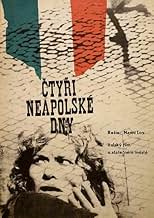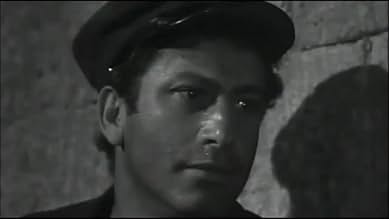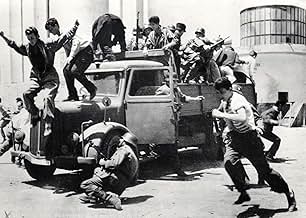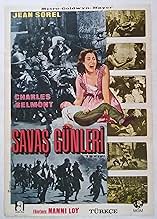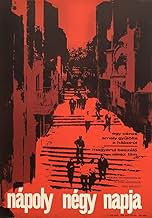VALUTAZIONE IMDb
7,6/10
1122
LA TUA VALUTAZIONE
La rivolta popolare napoletana contro gli invasori tedeschi durante la seconda guerra mondiale. In quattro giorni e poche ore vincono con fucili e pistole, armati di sassi, oggetti domestici... Leggi tuttoLa rivolta popolare napoletana contro gli invasori tedeschi durante la seconda guerra mondiale. In quattro giorni e poche ore vincono con fucili e pistole, armati di sassi, oggetti domestici e taniche di benzina.La rivolta popolare napoletana contro gli invasori tedeschi durante la seconda guerra mondiale. In quattro giorni e poche ore vincono con fucili e pistole, armati di sassi, oggetti domestici e taniche di benzina.
- Regia
- Sceneggiatura
- Star
- Candidato a 2 Oscar
- 9 vittorie e 9 candidature totali
Raffaele Barbato
- Giovanni Ajello
- (non citato nei titoli originali)
Charles Belmont
- Sailor
- (non citato nei titoli originali)
Regina Bianchi
- Concetta Capuozzo
- (non citato nei titoli originali)
Silvana Buzzanca
- Immacolata
- (non citato nei titoli originali)
Enzo Cannavale
- Partigiano
- (non citato nei titoli originali)
Luigi De Filippo
- Cicillo
- (non citato nei titoli originali)
Adriana Facchetti
- Scared Woman
- (non citato nei titoli originali)
Pasquale Fasciano
- Strongman
- (non citato nei titoli originali)
Domenico Formato
- Gennaro Capuozzo
- (non citato nei titoli originali)
Aldo Giuffrè
- Pitrella
- (non citato nei titoli originali)
Curt Lowens
- Sakau
- (non citato nei titoli originali)
Pupella Maggio
- Arturo's Mother
- (non citato nei titoli originali)
Rosalia Maggio
- Scared Woman
- (non citato nei titoli originali)
Alba Maiolini
- Grieving Woman
- (non citato nei titoli originali)
Lea Massari
- Maria
- (non citato nei titoli originali)
Recensioni in evidenza
10babuon
I saw this film when it first came out and it gripped me completely. I was quite young and not "into" foreign films, but this film caught me up. It showed a resistance that was unique -- not planned, not secret, but almost spontaneous. It mixes the buffoonery of some of the characters, the cowardice of a few and the bravery of the people of Naples. Some moments bring tears, others laughter. How the people come together to fight the Nazis who were still brutally exerting their power even as the allied forces marched north in Italy is a powerful statement of the will of ordinary Italian citizens.
For years I've tried to buy it, Le Quattro Giornate di Napoli, with no success. Then this year,TCM showed a very clean copy of it. But still I can't find a place to buy it. It is so worth having --
If anyone knows where I can buy it, I would be grateful.
For years I've tried to buy it, Le Quattro Giornate di Napoli, with no success. Then this year,TCM showed a very clean copy of it. But still I can't find a place to buy it. It is so worth having --
If anyone knows where I can buy it, I would be grateful.
This documentary-style drama shows us the determination of a civilian population to end wartime conscription by a former ally. The Nazi army tries by terror to force the Italian people to join them as they struggle on against the advance of the Allied forces in WWII Italy. Citizens decide against fighting the war any longer, and rally themselves to drive out the German soldiers from their city and their lives in only four days.
I watched this film in basic training camp in 1963. I did not know at the time if I was being ordered to Southeast Asia to participate in the war there or not. I had had a vision on the firing range that an active combat role in Viet Nam would be more terrible than I could ultimately live with in later years. Fortunately, I was sent to the staging area on Okinawa, and not to Viet Nam. I saw the film again when I reached Okinawa, and became aware of the war a thousand miles away.
The film crystalized for me that mankind could choose not to fight wars to settle disputes between countries, and that passionate citizens could resist the most disciplined of armies. The Neopolitan people's example to me from twenty years before, as I stood at the brink of the Southeast Asian war, spoke deeply to me of what humanity must strive to achieve through the advancement of its behavior and character.
I long to see the film again, or to read the source book, as world events swirl around us, echoing themes in the Four Days of Naples.
I watched this film in basic training camp in 1963. I did not know at the time if I was being ordered to Southeast Asia to participate in the war there or not. I had had a vision on the firing range that an active combat role in Viet Nam would be more terrible than I could ultimately live with in later years. Fortunately, I was sent to the staging area on Okinawa, and not to Viet Nam. I saw the film again when I reached Okinawa, and became aware of the war a thousand miles away.
The film crystalized for me that mankind could choose not to fight wars to settle disputes between countries, and that passionate citizens could resist the most disciplined of armies. The Neopolitan people's example to me from twenty years before, as I stood at the brink of the Southeast Asian war, spoke deeply to me of what humanity must strive to achieve through the advancement of its behavior and character.
I long to see the film again, or to read the source book, as world events swirl around us, echoing themes in the Four Days of Naples.
10sissoed
I just saw this 1962 film on Turner Classic Movies and promptly tracked down and ordered a VHS of it. A very realistic film with many characters whose stories start and in most cases are left unresolved in the midst of the fighting. The screenplay was original for the screen, not based on any book, and received a 1963 Oscar nomination in the original screenplay category. There is a 1979 book with the same title, also telling of the uprising, that is NOT the source of this film. According to summaries, the book says that the Naples "street boys" instigated and led the rebellion. Not in this film, however, which focuses on adults and has many wrenching scenes of mothers and children, husbands and wives torn apart. The ensemble cast is passionate and convincing. Unlike the other commenter who said the film is an argument against war, this is really an argument for standing up and fighting against those who would treat you as slaves (which the NAZIs did and which led to the uprising). Great film!
This film was brought to my attention by a friend who suggested that, since I enjoyed Roberto Rosselini's Open City, I would enjoy this film, which he considered to be even better than Rosselini's. I was impressed, to say the least, and inclined to agree. The story seemed infinitely more real and affecting.
Small stories of individual lives and relationships splintered apart by the actions of Germany in Naples after the Allies have declared victory in Europe in WWII isn't a subject many people will jump at the chance to see, but they should think again. We may never have the experience of being under occupation here in America, but that doesn't mean we can't appreciate and feel the bravery of a city that fights back against the tyranny of the weary German army. And if you have an aversion to war films, subtitled ones in particular, don't worry; the performances from the actors involved are strong enough to feed the emotions onto the screen without need of a translator.
This is a gem not many people know about. It's a shame. This is a film that needs a revolution in the minds of cineastes everywhere.
Small stories of individual lives and relationships splintered apart by the actions of Germany in Naples after the Allies have declared victory in Europe in WWII isn't a subject many people will jump at the chance to see, but they should think again. We may never have the experience of being under occupation here in America, but that doesn't mean we can't appreciate and feel the bravery of a city that fights back against the tyranny of the weary German army. And if you have an aversion to war films, subtitled ones in particular, don't worry; the performances from the actors involved are strong enough to feed the emotions onto the screen without need of a translator.
This is a gem not many people know about. It's a shame. This is a film that needs a revolution in the minds of cineastes everywhere.
A cast of virtual then-unknowns re-enacts the German takeover of Naples following the Italian Army's surrender to the Allies, and the peasant uprising which ensued. "The Four Days of Naples" was released in 1962 and is shown occasionally on Turner Classic Movies, in Italian with English subtitles.
What's most interesting about this film is that director Loy follows many characters and subplots, and often fails to resolve them because they become lost in the chaos of the house-to-house battle within the city. Frank Wolff ("Desert Assault") is Salvatore, who loves Maria (Lea Massari) even though she has married a rich man. The two wind up fighting along side one another; Gian Maria Volonte is the Captain who helps organize a partisan resistance; Aldo Giuffre (The Good, the Bad and the Ugly) is one member of an Italian artillery unit which becomes embroiled in the siege; and Enzo Turco ("Anzio") is a Black-shirt who is taken prisoner despite his Fascist convictions. Every member of the ensemble cast is passionate and utterly convincing. Many were virtually unknown at the time of production, and became big stars in Italy within the next few years.
Director Loy shoots his film with a documentary style. Some shots are well-crafted, though, and give the audience a new perspective on the action. One long pan from a rooftop from which partisans are firing on the Germans shows how the men move from street to street without any cutting at all. The black-and-white cinematography is utterly fantastic. Close-ups of faces deliver all of the drama that dialog simply cannot convey.
The film brings the viewer inside what occupation and resistance do the civilian population of a city. At one point, the Germans drive the citizens out of one quarter so that they can occupy it, forcing people to move in with strangers on the other side of the city. Later, they attempt to conscript Italian men into their labor force, which is what sparks the uprising. The camera follows us into individual homes and family situations, which are ripped apart by the affects of war. He then takes us to massive crowds as they riot in the streets. The scope of battle is excellently captured, as are the cramped alleys and rooms from which the citizens must fight.
There a number of standout vignettes: the Neapolitans throwing furniture from their windows atop the heads of Nazi soldiers in a narrow alleyway; one sequence in which a number of teens escape a reform school to join the fight; a prisoner-negotiation scene in which things go unexpectedly and several Italian civilians are caught in a crossfire; the scene in which the Italian men are taken in trucks to be conscripted, only to have their wives overwhelm the German guards. All of these scenes convey a spirit of freedom, aided by Carlo Rustichelli's rousing score.
"The Four Days of Naples" is a well-crafted drama, intended to be taken seriously, unlike many Italian war films which would follow a few years later. This is an inspiring drama of courage and determination, definitely a must-see for any fan of war films or the Italian cinema.
What's most interesting about this film is that director Loy follows many characters and subplots, and often fails to resolve them because they become lost in the chaos of the house-to-house battle within the city. Frank Wolff ("Desert Assault") is Salvatore, who loves Maria (Lea Massari) even though she has married a rich man. The two wind up fighting along side one another; Gian Maria Volonte is the Captain who helps organize a partisan resistance; Aldo Giuffre (The Good, the Bad and the Ugly) is one member of an Italian artillery unit which becomes embroiled in the siege; and Enzo Turco ("Anzio") is a Black-shirt who is taken prisoner despite his Fascist convictions. Every member of the ensemble cast is passionate and utterly convincing. Many were virtually unknown at the time of production, and became big stars in Italy within the next few years.
Director Loy shoots his film with a documentary style. Some shots are well-crafted, though, and give the audience a new perspective on the action. One long pan from a rooftop from which partisans are firing on the Germans shows how the men move from street to street without any cutting at all. The black-and-white cinematography is utterly fantastic. Close-ups of faces deliver all of the drama that dialog simply cannot convey.
The film brings the viewer inside what occupation and resistance do the civilian population of a city. At one point, the Germans drive the citizens out of one quarter so that they can occupy it, forcing people to move in with strangers on the other side of the city. Later, they attempt to conscript Italian men into their labor force, which is what sparks the uprising. The camera follows us into individual homes and family situations, which are ripped apart by the affects of war. He then takes us to massive crowds as they riot in the streets. The scope of battle is excellently captured, as are the cramped alleys and rooms from which the citizens must fight.
There a number of standout vignettes: the Neapolitans throwing furniture from their windows atop the heads of Nazi soldiers in a narrow alleyway; one sequence in which a number of teens escape a reform school to join the fight; a prisoner-negotiation scene in which things go unexpectedly and several Italian civilians are caught in a crossfire; the scene in which the Italian men are taken in trucks to be conscripted, only to have their wives overwhelm the German guards. All of these scenes convey a spirit of freedom, aided by Carlo Rustichelli's rousing score.
"The Four Days of Naples" is a well-crafted drama, intended to be taken seriously, unlike many Italian war films which would follow a few years later. This is an inspiring drama of courage and determination, definitely a must-see for any fan of war films or the Italian cinema.
Lo sapevi?
- QuizAll actors accepted to be uncredited in honor of the civilians who died during the uprising and remained without official recognition.
- BlooperAt the beginning of the scene in which Allejo and his gang of kids are having a shootout from the mountain train and Cazzillo gets shot, around 1h 31min, a piece of glass in front of him reflects the crew.
- Curiosità sui creditiWhen the MGM lion roars, no sound comes out of its mouth.
- ConnessioniEdited into Film socialisme (2010)
I più visti
Accedi per valutare e creare un elenco di titoli salvati per ottenere consigli personalizzati
- How long is The Four Days of Naples?Powered by Alexa
Dettagli
Botteghino
- Budget
- 800.000 USD (previsto)
- Tempo di esecuzione
- 2h(120 min)
- Colore
- Mix di suoni
- Proporzioni
- 1.66 : 1
Contribuisci a questa pagina
Suggerisci una modifica o aggiungi i contenuti mancanti

